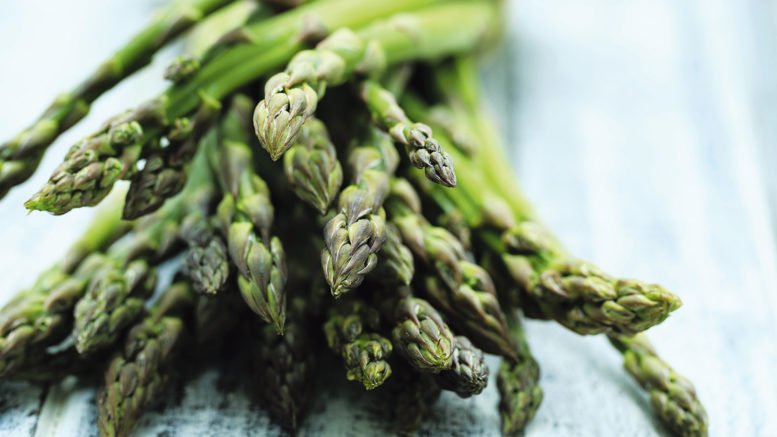Asparagus, potato and ham soup
Sep 11, 2020
Well, Spring is here. Without a doubt, my favourite season of the year.
Time to move on from our immunity series and dive straight into our next topic: Spring Cleansing and Self Care.
This week I thought I’d focus on one of my all-time favourite foods: asparagus.
Most of us think of asparagus as a delicious, Spring vegetable – one that’s sexy enough to grace every fine dining menu, come early Spring.
And if you’re like me, you may also
have some residual childhood trauma associated with the canned variety – it’s one vegetable that simply doesn’t lend itself to that particular preservation method.
Frankly, I think this should have been more obvious at the time, to whomever came up with the idea!
A prebiotic …

No doubt many of us consider asparagus to be a healthy choice as far as veggies go
If you run in health circles, you’ve probably seen it featured in every ‘top 10’ list of best prebiotic foods.
Prebiotics are a particular type of fibre that feed the beneficial bacteria in our digestive tract, helping them to proliferate.
And whilst probiotics have stolen all the glory in recent years, consuming sufficient prebiotic fibre is actually much more central to maintaining a healthy gut.
Asparagus, being such an abundant source of prebiotic fibre, is indeed a unique and wonderful food for this purpose and a great post-Winter cleansing food for this reason.
… but much, much more
However, asparagus deserves so much more credit in the health stakes! In fact, historically it has been used as a traditional herbal medicine in China. What did they know that we’ve overlooked?
Whilst asparagus has been traditionally used to treat fevers, cough and hair loss, among other things, recent studies have indicated that it has a much broader range of applications thanks to its anti-fungal, antioxidant and anti-inflammatory properties and may be useful in the treatment of high blood pressure, high cholesterol and hyperglycaemia.
Various bioactive substances have been identified in asparagus.
It is one of the richest sources of rutin, which is predominantly composed of the flavonol quercetin – both are powerful antioxidants.
Now, one of my passions is finding creative ways to utilise the whole plant (root to tip) and the whole animal (nose-to-tail), just as many traditional cultures did.
Not only does eating this way provide a much broader spectrum of nutrients – and we’ll go into more detail in upcoming columns as it’s a fascinating topic – it minimises food waste and there’s a sense of achievement and satisfaction that comes with using every part.
What to do with those woody stems?
What I’ve found repeatedly over the years, is that often we Westerners are unwittingly discarding the most nutrient dense part of the plant or animal! And this is certainly the case with asparagus.
The bottom woody part of the stem is usually removed because of its toughness, however this section contains powerfully active compounds in far greater amounts than the delicate green stems we all enjoy eating.
Approximately three times the amount of rutin can be found in asparagus bottom stems and this section also contains protodioscin, an antitumor substance, at a level over a hundred times that seen in the green stems.
Do I have any suggestions for how to make use of the woody stems? Well, not from experience, as yet. Aside from making a tea from them, the only thing I’m tempted to try is pickling, which generally helps to break down fibre whilst leaving the nutrients intact.
If anyone happens to try this, over the course of Springtime, please let me know.
Regardless, I hope you take the opportunity this Spring, to go ahead and indulge in this delicious medicinal plant, whilst it is at its peak.
And if you’re looking for creative ways to enjoy it – not that anything really beats lightly blanched in heavily salted water and topped with lemon, parmesan and a good quality olive oil – here is a delicious soup that I whipped up the other week, to rave reviews.
Asparagus, potato and ham soup

There are a few options for this soup, depending on your level of time and commitment.
I couldn’t help making a broth beforehand, because that’s just the way things go in my kitchen and I know it’s the secret to a really delicious and nourishing soup.
I happened to use both some smoked pork bones that had been in the back of my freezer for a tad too long (from local butchery The Ethical Farmers) and also a smoked pork hock.
The latter has the skin intact, which results in the most silky, gelatinous broth you can imagine.
Either of these ingredients would make a great broth on its own, but I was entertaining, so went with both.
This step is simple: place all the bones in a pot with enough water to cover and simmer gently for 2-4 hours.
You may need to add water depending on the cooking time, to keep the bones partly submerged. Strain the resulting broth to include in the soup.
If using the pork hock, simply pick the meat off the bone and either add it into the soup or save it for another dish.
If you’re marginally less obsessed with broth than I am – and let’s face it, it wouldn’t be unlikely – I’m fairly confident this soup would still be a crowd-pleaser if you substituted water in its place.
I’d add a bit of extra cream or butter to compensate and an extra pinch of salt.
Ingredients
1 kg smoked pork bones or 1 pork hock
1.5 tbsp. olive oil
6 large shallots
3 cloves garlic, sliced
1kg potatoes, peeled and quartered
300g ham, roughly chopped
4 bunches asparagus, bottom stems removed, roughly chopped
50g butter
Salt and pepper, to taste
1.
Pre-make the pork broth first, so that you have it on hand for the soup.
2.
Heat the olive oil and saute the shallots for 3 minutes in a large pot over high heat. Add the garlic and sauté for an extra 2 minutes or until the shallots are soft and translucent, stirring frequently to prevent burning.
3.
Add the potatoes, reduce the heat to medium and continue to saute for another 15 minutes, stirring occasionally. Pour over the stock and additional water if necessary, to cover the potatoes. Bring to the boil, then reduce the heat and simmer, covered, for 20 minutes or until the potatoes are well-cooked.
4.
Add the ham and asparagus and simmer for another 7 minutes. Remove from the heat, allowing it to cool slightly, before adding the butter and blending well into a silky-smooth soup. Texture matters, here. You cannot over-blend, folks!
5.
Add a pinch of salt if necessary and some pepper to season, then serve with some homemade hollandaise if you dare.

Stay connected with news and updates!
Join our mailing list to receive the latest news and updates from our team.
Don't worry, your information will not be shared.
We hate SPAM. We will never sell your information, for any reason.

